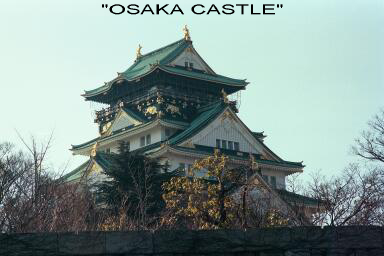|
|
![]()
© By: David E. J. Pepin
Sukenao served his apprenticeship in the workshop of Sukehiro I, and soon became the student of Sukehiro II. Sukehiro II, recognizing Sukenao's extraordinary talent, placed him in the position of foremost student. Sukehiro II had other students: Hiromasa, Suketaka, and Sukemune, to name a few. However, Sukenao was the only one who was able to step forth from the aura of fame surrounding his sensei, and be recognized for his own ability. It was during these years that he presumably married the young sister of Sukehiro II. It is also apparent that he was regarded as more of a son than a son-in-law, thus the theory was formed that he may have been the adopted son of Sukehiro I. Sukenao used the surname of Sukehiro "Tsuda," indicating a very close bond between them.
Sukehiro II, was summoned to Osaka Castle (see
photo) in kanbun 6 (1666) to serve as master swordsmith for the Daimyo Aoyama
Inaba-no-Kami, the "HANJI" (chief magistrate or judge) of the castle. It was
from this time that his techniques, and the refinement of his work's rapidly
progressed. It was in Enpo that he changed the style of his kanji from kaku
(square) to maru (rounded). This is significant because, it is believed that
Sukenao joined him at the castle. This is indicated by the the fact that, in
Enpo 3rd Sukenao first used the
surname "Tsuda".
It was not seen for the next 7 year's. I believe he did so to distinguish the
blade's he solely produced from those made with sukehiro, at

Sukenao produced this blade in 1683, during the reign of the 5th Shogun “TOKUGAWA TSUNAYOSHI”, ruler of Osaka Castle from 1680 to 1709. TSUNAYOSHI O-SAMA, was known as the “Dog Shogun”, as he was obsessed with the protection of animals, practically dogs! This could have well been the first “Save the animals” campaign in the history of Japan.
After Sukehiro's death in Tenwa 2 (1682), he began the use of "tsuda" once again. He also changed the the style of his kanji from Kaku (square), to maru (rounded), as did Sukehiro! He worked actively as the head of the Tsuda school, and was the actual successor of "Tsuda Sukehiro"! He was given the name "magodaiyu" (manager or steward).
It is believed that Sukenao died in 1693 at the
age of 54 (a respectable age for the period), after a very prolific career.
